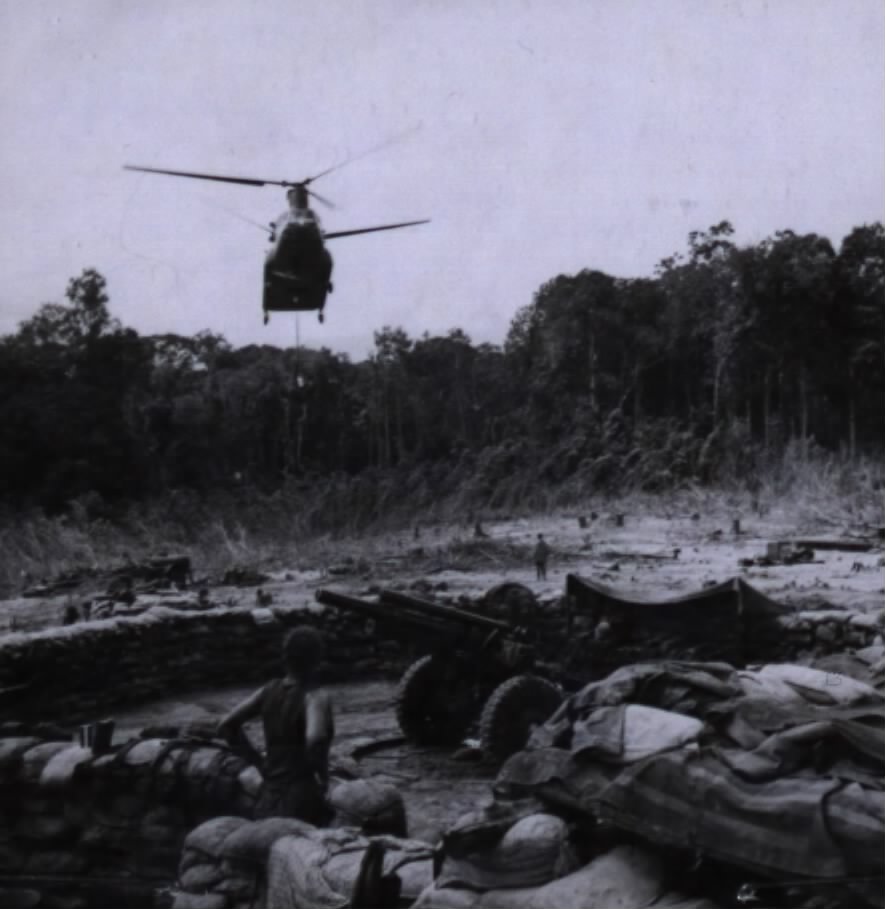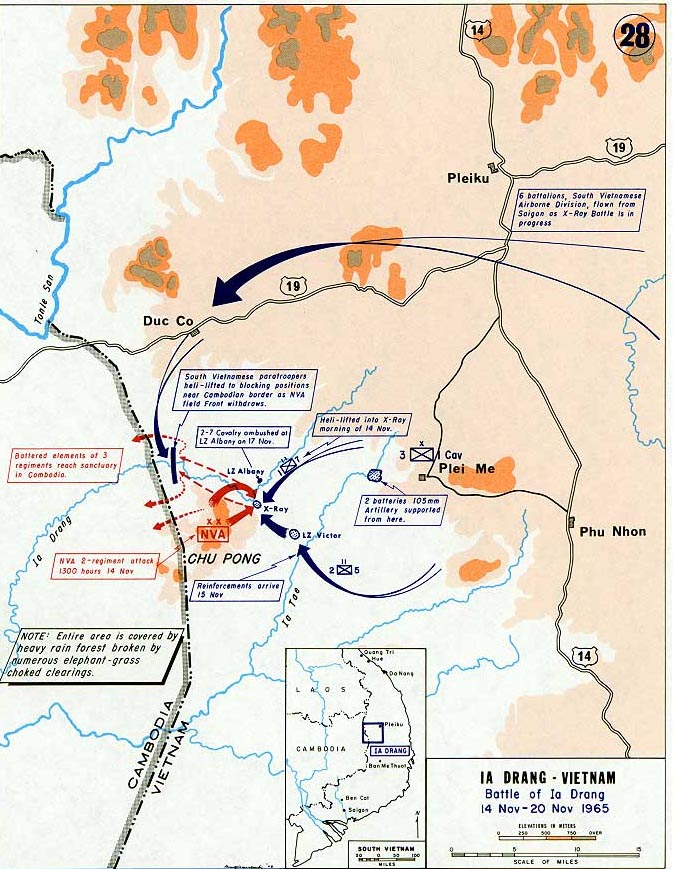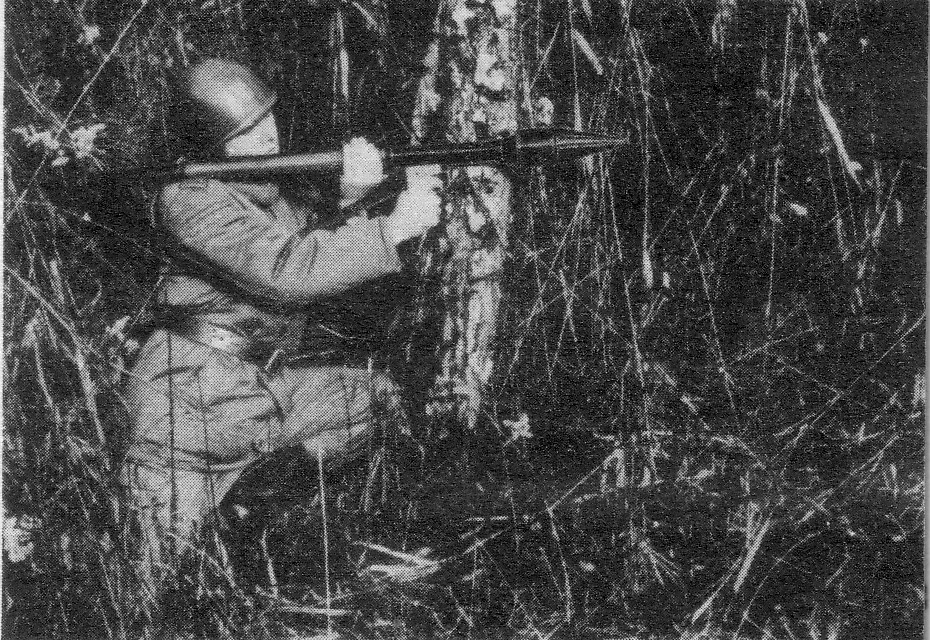|
Operation Francis Marion
Operation Francis Marion was a 4th Infantry Division and 173rd Airborne Brigade operation that took place in Pleiku, Darlac and the Kon Tum Provinces, South Vietnam, lasting from 6 April to 11 October 1967. Background The operation was a continuation of the recently concluded Operation Sam Houston in the same general area. 4th Infantry Division commander MG William R. Peers planned a defense in depth against People's Army of Vietnam (PAVN) incursions from Base Areas 701 and 702 across the Cambodian border. Operation Operation Francis Marion commenced on 6 April. The 1st Brigade, 4th Infantry Division deployed in an arc 20 km east of the Cambodian border along Highway 14B and the north-south line of U.S. Special Forces camps at Plei Djereng, Đức Cơ and Plei Me, with the 2nd Brigade held as a reserve force. Special Forces, CIDG units and the 4th Division's long-range reconnaissance teams would search the area west of this line to the Cambodian border. The Ar ... [...More Info...] [...Related Items...] OR: [Wikipedia] [Google] [Baidu] |
Vietnam War
The Vietnam War (also known by #Names, other names) was a conflict in Vietnam, Laos, and Cambodia from 1 November 1955 to the fall of Saigon on 30 April 1975. It was the second of the Indochina Wars and was officially fought between North Vietnam and South Vietnam. The north was supported by the Soviet Union, China, and other communist states, while the south was United States in the Vietnam War, supported by the United States and other anti-communism, anti-communist Free World Military Forces, allies. The war is widely considered to be a Cold War-era proxy war. It lasted almost 20 years, with direct U.S. involvement ending in 1973. The conflict also spilled over into neighboring states, exacerbating the Laotian Civil War and the Cambodian Civil War, which ended with all three countries becoming communist states by 1975. After the French 1954 Geneva Conference, military withdrawal from Indochina in 1954 – following their defeat in the First Indochina War – the Viet Minh to ... [...More Info...] [...Related Items...] OR: [Wikipedia] [Google] [Baidu] |
Siege Of Plei Me
The siege of Plei Me ( vi, Bao vây Plei Me; 19–25 October 1965) was the beginning phase of the first major confrontation between soldiers of the North Vietnamese People's Army of Vietnam (PAVN) and the U.S. Army during the Vietnam War. The lifting of the siege by South Vietnamese forces and American air power was followed by the pursuit of the retreating North Vietnamese from 28 October until 12 November, setting the stage for the Battle of Ia Drang. Background Plei Me camp was established in October 1963 by the United States Army Special Forces south of Pleiku city and less than from the Cambodian border in the Central Highlands of South Vietnam. Plei Me was one of many Special Forces camps scattered around the Central Highlands and charged with gaining and maintaining the support of the Montagnards for the South Vietnamese war effort and gathering intelligence about the infiltration into South Vietnam of North Vietnamese soldiers along the Ho Chi Minh trail. In 1965 t ... [...More Info...] [...Related Items...] OR: [Wikipedia] [Google] [Baidu] |
RPG-2
The RPG-2 (Russian: РПГ-2, Ручной противотанковый гранатомёт, ''Ruchnoy Protivotankovy Granatomyot''; English: "hand-held antitank grenade launcher") is a man-portable, shoulder-fired anti-tank weapon that was designed in the Soviet Union. It was the first successful anti-tank weapon of its type, being a successor to the earlier and unsuccessful RPG-1. The RPG-2 offered better range and armor penetration, making it useful against late and post-World War II tanks, in contrast to the RPG-1 that had only marginal utility. The basic design and layout was further upgraded to produce the ubiquitous RPG-7. History Studying German and US anti-tank rocket designs, in 1944 the Soviets began development of the RPG-1 with the goal of combining the best features of the German ''Panzerfaust'' single shot recoilless weapon with the US Bazooka rocket launcher. Propelled by a 30 mm cartridge, the high explosive anti-tank (HEAT) round could penetrate about of ... [...More Info...] [...Related Items...] OR: [Wikipedia] [Google] [Baidu] |
12th Infantry Regiment (United States)
The 12th Infantry Regiment is a unit of the United States Army. The 12th Infantry has fought in seven wars from the Civil War to the Global War on Terrorism and has been awarded 19 Presidential Unit Citations, five Valorous Unit Awards, a Joint Meritorious Unit Award, two citations in the Order of the Day of the Belgian Army, Nine Republic of Vietnam Crosses of Gallantry, the Republic of Vietnam Civil Action Honor Medal Third Class, a Meritorious Unit Commendation, and the Belgian Fourragere. History Civil War Less than a month after the first shots of the Civil War were fired at Fort Sumter in South Carolina, the 12th Infantry Regiment was constituted 3 May 1861 in the Regular Army as the 1st Battalion, 12th Infantry. It was organized 20 October 1861 at Fort Hamilton in New York. The battalion saw extensive combat during the Civil War, participating in twelve campaigns with the Army of the Potomac. During the Peninsula Campaign, the 12th Infantry distinguished itself in ... [...More Info...] [...Related Items...] OR: [Wikipedia] [Google] [Baidu] |
Boeing B-52 Stratofortress
The Boeing B-52 Stratofortress is an American long-range, subsonic, jet-powered strategic bomber. The B-52 was designed and built by Boeing, which has continued to provide support and upgrades. It has been operated by the United States Air Force (USAF) since the 1950s. The bomber is capable of carrying up to 70,000 pounds (32,000 kg) of weapons,"Fact Sheet: B-52 Superfortress." ''Minot Air Force Base'', United States Air Force, October 2005. Retrieved: 12 January 2009. and has a typical combat range of around 8,800 miles (14,080 km) without aerial refueling. Beginning with the successful contract bid in June 1946, the B-52 design evolved from a [...More Info...] [...Related Items...] OR: [Wikipedia] [Google] [Baidu] |
Landing Zone Oasis
Landing Zone Oasis (also known as LZ Oasis or LZ Tuttle) is a former U.S. Army base southwest of Pleiku in central Vietnam. History The base was first established in 1965 by the 1st Cavalry Division for the Battle of Ia Drang, just south of QL-19 and approximately 24 km southwest of Pleiku. The base was originally named after SSGT Arlen Tuttle, an Engineer from the 8th Engineer Battalion, 1st Cavalry Division who was killed in action on 5 November 1965. The base was reopened in May 1966 by Task Force Walker of the 25th Infantry Division. The base was later used by the 3rd Brigade, 4th Infantry Division. On 11 May 1969 the base was attacked by an estimated 600 People's Army of Vietnam (PAVN) troops, resulting in 11 U.S. and approximately 100 PAVN killed and 3 U.S. captured. On 30 October 1970 the base, occupied by 6th Battalion, 14th Artillery and elements of B Battery, 4th Battalion, 60th Artillery, was attacked by the PAVN, resulting in 3 U.S. deaths and 20 U.S. wo ... [...More Info...] [...Related Items...] OR: [Wikipedia] [Google] [Baidu] |
Canister Shot
Canister shot is a kind of anti-personnel artillery ammunition. Canister shot has been used since the advent of gunpowder-firing artillery in Western armies. However, canister shot saw particularly frequent use on land and at sea in the various wars of the 18th and 19th century. Canister is still used today in modern artillery. Description Canister shot consists of a closed metal cylinder typically loosely filled with round lead or iron balls packed with sawdust to add more solidity and cohesion to the mass and to prevent the balls from crowding each other when the round was fired. The canister itself was usually made of tin, often dipped in a lacquer of beeswax diluted with turpentine to prevent corrosion of the metal. Iron was substituted for tin for larger-caliber guns. The ends of the canister were closed with wooden or metal disks. A cloth cartridge bag containing the round's gunpowder used to fire the canister from the gun barrel could be attached to the back of the m ... [...More Info...] [...Related Items...] OR: [Wikipedia] [Google] [Baidu] |
8th Infantry Regiment (United States)
The 8th Infantry Regiment of the United States, also known as the "Fighting Eagles," is an infantry regiment in the United States Army. The 8th Infantry participated in the Mexican War, American Civil War, Philippine Insurrection, Moro Rebellion, World War I, World War II, Vietnam War, and Iraq Campaign. Coat of arms Blazon #Shield: Argent on a bend azure (heraldry), between (in sinister chief) a tomahawk Gules halved Sable and an arrow of the last barbed of the third in saltire and in dexter base an eagle's claw erased Proper, three roses of the field seeded of the third. #Crest: On a wreath of the colors Argent and Azure out of a mural coronet a dexter arm in armor embowed the hand grasping a flagstaff with tassel all Proper. #Motto: "PATRIAE FIDELITAS" (Loyalty to Country). Symbolism *Shield: #The shield is white with a blue bend, the Infantry colors. #The three heraldic flowers on the bend are symbolic of: first, the Rose, the flower of the state of New York, where ... [...More Info...] [...Related Items...] OR: [Wikipedia] [Google] [Baidu] |
Tân Cảnh Base Camp
Tân Cảnh Base Camp (also known as Đắk Tô 1) is a former U.S. Army and Army of the Republic of Vietnam (ARVN) base northwest of Kon Tum in the Central Highlands of Vietnam. History 1962–67 The 5th Special Forces Group Detachment A-333 first established a base at Đắk Tô in 1962 to monitor communist infiltration along the Ho Chi Minh Trail. In early-mid 1967 increased infiltration into the Central Highlands led Major General William R. Peers commander of the 4th Infantry Division to request reinforcements and the 173rd Airborne Brigade was moved by air to Đắk Tô in June 1967. As the existing Special Forces base camp and airfield were too small to accommodate large numbers of troops and their support requirements, a new airfield and base camp known as Đắk Tô 2 and Đắk Tô Base Camp were established several kilometres further west, approximately 40 km northwest of Kon Tum and the former camp became known as Tân Cảnh Base Camp. 1972 In early 197 ... [...More Info...] [...Related Items...] OR: [Wikipedia] [Google] [Baidu] |
Kon Tum
Kon Tum is the capital city of Kon Tum Province in Vietnam. It is located inland in the Central Highlands region of Vietnam, near the borders of Laos and Cambodia. History After the People's Army of Vietnam invaded South Vietnam on March 30, 1972 during the Easter Offensive, two divisions attempted to capture Kon Tum, but failed. In March 1975, however, Kon Tum was overrun during the Ho Chi Minh Campaign and large numbers of refugees were forced to flee east to the south central coast. Kon Tum has several vestiges of the French colonial period, as well as several tribal villages directly in the suburbs of the Vietnamese-reconstructed town. Among the town's landmarks, there is a Roman Catholic wooden church on discrete stilts and a large French-built seminary which hosts a small museum on local hill tribes. French missionary presence in Kon Tum traces back to 1851. Climate Kon Tum has a tropical savanna climate (Köppen Köppen is a German surname. Notable people with the sur ... [...More Info...] [...Related Items...] OR: [Wikipedia] [Google] [Baidu] |
23rd Division (South Vietnam)
The 23rd Division of the Army of the Republic of Vietnam (ARVN)—the army of the nation state of South Vietnam that existed from 1955 to 1975—was part of the II Corps that oversaw the Central Highlands. History In 1960 the 23rd Infantry Division was formed from the 15th Light Division and elements of the 16th Light Division. On 29 July 1965, as a show of force, United Front for the Liberation of Oppressed Races (FULRO) troops seized a Highland Civilian Irregular Defense Group (CIDG) border camp at Buon Brieng in Darlac Province, withdrawing several days later with 176 CIDG personnel. When elements of the Division reoccupied the camp, and forced several hundred FULRO supporters to join local South Vietnamese Regional Forces (RF) units, tensions increased further. In mid-December FULRO launched a series of coordinated attacks in the Highland Provinces of Quang Duc and Phu Bon, seizing a province headquarters and killing 32 ARVN troops before government forces, includi ... [...More Info...] [...Related Items...] OR: [Wikipedia] [Google] [Baidu] |







